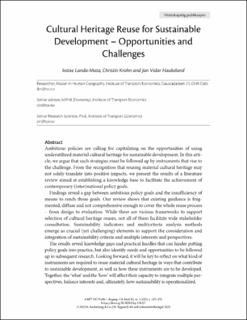| dc.contributor.author | Landa-Mata, Iratxe | |
| dc.contributor.author | Krohn, Christin | |
| dc.contributor.author | Haukeland, Jan Vidar | |
| dc.coverage.spatial | Norway, Oslo | en_US |
| dc.date.accessioned | 2024-01-26T12:11:41Z | |
| dc.date.available | 2024-01-26T12:11:41Z | |
| dc.date.created | 2023-12-13T10:41:16Z | |
| dc.date.issued | 2023-11-06 | |
| dc.identifier.citation | Kart og Plan. 2023, 116, bind 83 (3-2023), 167-192. | en_US |
| dc.identifier.issn | 0047-3278 | |
| dc.identifier.uri | https://hdl.handle.net/11250/3114079 | |
| dc.description | Kart og Plan is a scholarly journal with open access. All journal content is published online with immediate free access. | en_US |
| dc.description.abstract | Ambitious policies are calling for capitalizing on the opportunities of using underutilized material cultural heritage for sustainable development. In this article, we argue that such strategies must be followed up by instruments that rise to the challenge. From the recognition that reusing material cultural heritage may not solely translate into positive impacts, we present the results of a literature review aimed at establishing a knowledge base to facilitate the achievement of contemporary (inter)national policy goals. Findings reveal a gap between ambitious policy goals and the insufficiency of means to reach those goals. Our review shows that existing guidance is fragmented, diffuse and not comprehensive enough to cover the whole reuse process – from design to evaluation. While there are various frameworks to support selection of cultural heritage reuses, not all of them facilitate wide stakeholder consultation. Sustainability indicators and multicriteria analysis methods emerge as crucial (yet challenging) elements to support the consideration and integration of sustainability criteria and multiple interests and perspectives. The results reveal knowledge gaps and practical hurdles that can hinder putting policy goals into practice, but also identify needs and opportunities to be followed up in subsequent research. Looking forward, it will be key to reflect on what kind of instruments are required to reuse material cultural heritage in ways that contribute to sustainable development, as well as how these instruments are to be developed. Together, the ‘what’ and the ‘how’ will affect their capacity to integrate multiple perspectives, balance interests and, ultimately, how sustainability is operationalized. | en_US |
| dc.description.abstract | Cultural Heritage Reuse for Sustainable Development – Opportunities and Challenges | en_US |
| dc.language.iso | eng | en_US |
| dc.publisher | Universitetsforlaget | en_US |
| dc.rights | Navngivelse 4.0 Internasjonal | * |
| dc.rights | Navngivelse 4.0 Internasjonal | * |
| dc.rights.uri | http://creativecommons.org/licenses/by/4.0/deed.no | * |
| dc.title | Cultural Heritage Reuse for Sustainable Development – Opportunities and Challenges | en_US |
| dc.title.alternative | Cultural Heritage Reuse for Sustainable Development – Opportunities and Challenges | en_US |
| dc.type | Journal article | en_US |
| dc.type | Peer reviewed | en_US |
| dc.rights.holder | © Authors. | en_US |
| dc.description.version | publishedVersion | en_US |
| cristin.ispublished | true | |
| cristin.fulltext | original | |
| cristin.qualitycode | 1 | |
| dc.identifier.doi | 10.18261/kp.116.3.7 | |
| dc.identifier.cristin | 2212806 | |
| dc.source.journal | Kart og Plan | en_US |
| dc.source.volume | 116, bind 83 | en_US |
| dc.source.issue | 3-2023 | en_US |
| dc.source.pagenumber | 167-192 | en_US |
| dc.relation.project | Norges forskningsråd: 320655 | en_US |

